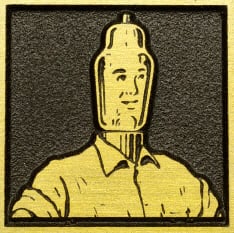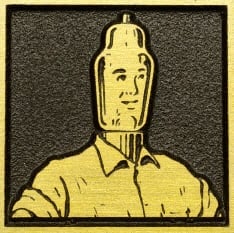
The Bottlehead Technology Story
Pretty much all of the Bottlehead products incorporate some uncommon technologies which contribute to the exceptional sound. This page describes the main ones.
Parallel Feed
In parallel feed, the usual air-gapped output transformer is divided into an air-gapped plate choke and an output transformer with interleaved core laminations. They are coupled together with a high-quality capacitor. The choke does not need to have interleaved windings, so it can be made to have a large inductance (good bass) and still retain a small capacitance (good treble). The transformer can be much smaller because it does not have to handle the DC current, and the smaller size permits it to have good high frequency response without excess interleaving and the capacitance that results. Sonically, this means deeper, cleaner bass without sacrificing the highs.
The plate load choke also isolates the output stage from the power supply. This suppresses the power supply hum and noise. Sonically, this means less noise and power line interference, and blacker backgrounds. And because it isolates the audio current loop from the power supply, the power supply capacitor does not affect the sound. More and more, we are also returning the loop current to the cathode in order to get the cathode bypass capacitor out of the loop. By getting these large capacitors out of the loop, their distortions are removed without the bulk and expense of large film capacitors.
If the parafeed coupling capacitor is correctly chosen, and if the speaker impedance is nearly resistive near the low frequency cutoff, the tube can be made to see a nearly resistive load to a lower frequency that one would calculate from the inductances alone. This smaller phase shift reduces tube-generated low frequency distortion., giving a clearer, more articulate bass.
Direct Coupling
The obvious advantage of direct coupling is that it eliminates a capacitor from the signal path. Since virtually all capacitors have audible sonic flaws, this must be an advantage. It requires a greater power supply voltage, which means only preamplifiers and low-powered power amplifiers can be done this way if voltages are to be kept reasonable.
A second advantage not often appreciated in the literature is that the output tube can be overdriven without shifting its bias point. All conventional capacitor-coupled circuits will undergo a large shift in operating point when overloaded, even momentarily. This produces a “crunchy” sound, which is highly prized in a guitar amplifier but not much appreciated in an audiophile system.
Sonically, the result is a more graceful overload characteristic, and an overall cleaner sound with less apparent distortion.
Active Current Source Loading
By loading a triode voltage amplifier with a high impedance, such as an active current source, it operates in a more linear region and produces less distortion. This is especially important in a driver, because the best sounding amplifiers appear to be those whose distortion signature is dominated by a single tube, usually the output tube. In other words, the driver distortion should be less than the output tube’s. This is surprisingly difficult when extremely linear output tubes are being used, such as the 2A3 and 300B. Very few small-signal tubes are as low in distortion.
Sonically, this gives a clean sound with clarity and detail. It also gives a large improvement in bass impact and solidity.
Cathode-bias voltage sources
We use fixed cathode bias in most small signal and driver applications, usually a specially-chosen, low impedance LED or a shunt regulator. These devices replace the usual resistor/bypass capacitor combination, removing a capacitor from the circuit. Since this capacitor must usually be a large value, electrolytic types are almost universally used in spite of their poor sonic reputation.
In some cases, we use a split-rail power supply, where the cathode resistor is used to create a negative voltage with respect to signal ground. This is sometimes called a “Western Electric” connection, because they used it extensively in their early designs from the Twenties and Thirties. This makes it practical to return the parafeed output transformer to the cathode even if the output transformer is not rated to operate with a DC voltage between the primary and the core or secondary.
When an ordinary bias resistor/capacitor combination is used in an output stage, it is always with the primary of the DC-rated output transformer returned to the cathode, which keeps the signal current out of the capacitor.
Shunt regulation
No one disputes the advantages of a regulated high voltage power supply, which provides stability of operating point against power line fluctuations and against fluctuating current demands of other stages. Even with a regulated supply voltage, if you look at the current loop for the output signal of an ordinary voltage gain stage you will see that some of it goes through the power supply. In the case of a cathode follower, all of the current does so; with parafeed it is a small portion, and with the current source loaded voltage amplifier a tiny portion. We have found that a triode-bas ed shunt regulator is better at handling this current fluctuation than the usual series regulator. The sonic advantages are significant, and surprisingly audible even with current source loaded voltage amplifiers. We are now using this technology with all cathode followers, and with many driver stages as well. Sonic advantages are similar to current source loading – cleaner, more detailed sound and bass with more impact and solid articulation.
DC heaters and filaments
AC power for the cathode adds hum and powerline noise to the signal, whether it is directly or indirectly heated. This can be solved with DC power, but that usually introduces other problems. These facts have always been known, and we have been searching for suitable answers for a long time. We have developed a couple solutions, and are using them in an increasing number of products.
For indirectly heated tubes, Schottky diodes are used to eliminate the reverse recovery spike (which causes the power transformer to ring ultrasonically, adding a bit of glare to the sound), and an RC filter is used to reduce the charging current peak for the same reason. A stronger CRC filter would r educe the ripple further, but at the price of increased peak charging currents which we find are a worse problem.
For the directly heated triodes, filament supplies have long been problematical. The filament is also the cathode, and the output is equally sensitive to noise voltage on the grid or cathode, so the power source must be especially quiet. And it must be quiet in both common-mode and differential mode, a distinction that is often neglected. We now use custom transformers which shield the filament winding electrostatically from the other windings. For DC supplies, we have taken several steps to eliminate sources of noise and sonic roughness. First, there is no capacitor, only an inductance between the Schottky rectifiers and the filament. The choke-input filter eliminates sharp current transients, and the Schottkys don’t have spikes like normal diodes. The filter choke is split so its operation is balanced, and wound on a dual-bay bobbin arranged to have a substantial leakage inductance which acts as a common-mode choke, in addition to its normal duties as a differential mode choke. As with the indirectly heated DC power, the residual ripple is reduced substantially but not completely; we feel the other advantages of this arrangement are more important sonically than just getting the very best ripple measurements.
Layout, Grounding, and Shielding
Safety is always a consideration, especially with kits where the manufacturer has no control over how the final product is assembled. It is not possible to get approval from safety agencies in that case, though we follow the common safety design rules. We also use three-wire power cords with the chassis safety grounded, as another layer of protection. Though some feel that can create a ground loop, we have not found it to be a problem as long as everything is powered from the same outlet.
Hum, buzz and other noises have always been a problem in audio gear, and it is especially difficult when you don’t use feedback to mask the problem. We have been incorporating more and more strategies to minimize these artifacts, guided by our experience. Some theoretically desirable strategies have been abandoned when they did not perform in the real world. Currently we use star grounding to the chassis for RFI shielding; careful attention is paid in wire routing to minimize electric and magnetic pickup, and small signal connections of any length use shielded twisted pair for the same reason. Custom power transformers are designed for low radiated magnetic and electric fields, and for DHT filament power they include internal electrostatic shielding as well. Transformer cores are isolated and separately grounded to reduce eddy currents in the chassis. Transformers are positioned and oriented for minimal magnetic pickup as well.

